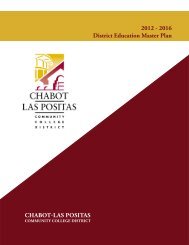City College of San Francisco - California Competes
City College of San Francisco - California Competes
City College of San Francisco - California Competes
Create successful ePaper yourself
Turn your PDF publications into a flip-book with our unique Google optimized e-Paper software.
STANDARD II.A<br />
According to a recent report, 43 percent <strong>of</strong><br />
first-time students are placed into one or two<br />
lower-level pre-collegiate courses. Additionally,<br />
33 percent are placed into one or two upperlevel<br />
pre-collegiate courses. The Basic Skills<br />
Subcommittee and the Diversity Committee<br />
are working on proposals to increase the success<br />
rate <strong>of</strong> these students.<br />
The creation and dissemination <strong>of</strong> data regarding<br />
the identification <strong>of</strong> student learning needs<br />
changed significantly when the Office <strong>of</strong><br />
Research, Planning and Grants set the goal <strong>of</strong><br />
creating an information-rich environment in<br />
the late 1990s. The DSS has provided highly<br />
accessible data to the <strong>College</strong> community regarding<br />
student demographics, enrollment trends,<br />
graduation rates, and other types <strong>of</strong> statistical<br />
data. A recent external study indicated that the<br />
DSS has not only changed the way research is<br />
used, but also the speed at which research is<br />
available. The study concluded that the DSS has<br />
democratized the dissemination <strong>of</strong> information,<br />
making it widely available to the <strong>College</strong> community.<br />
As a result, data are used more <strong>of</strong>ten to<br />
substantiate claims for additional resources, or to<br />
make decisions regarding the need for more class<br />
sections or the need to market a program to a<br />
larger audience. In addition, the study reported<br />
that pre-existing negative attitudes about the<br />
source <strong>of</strong> these data are being dismantled.<br />
[Ref. 2]<br />
The Office <strong>of</strong> Research, Planning and Grants<br />
now publishes numerous reports that are available<br />
on the website maintained by this <strong>of</strong>fice. A<br />
review <strong>of</strong> the December 2003 Mid-Year Summary<br />
Report from this <strong>of</strong>fice indicates a total <strong>of</strong> 183<br />
requests for information were received and<br />
responded to during the Fall 2003 semester.<br />
[Ref. 23] Most <strong>of</strong> these requests for data originated<br />
from an administrative <strong>of</strong>fice or department.<br />
A survey was conducted in Fall 2004 to determine<br />
how the provided data were used and<br />
whether these data were used to identify student<br />
needs and assess student learning outcomes.<br />
In addition, this <strong>of</strong>fice provides a Program<br />
Review Data Book to all departments when they<br />
undergo Program Review. [Ref. 24] These data<br />
books include student success data, demographic<br />
data, weekly student contact hours (WSCH),<br />
and faculty load data. Also included are student<br />
success data for the entire institution and sample<br />
registration outcomes data. The Office <strong>of</strong><br />
Research, Planning and Grants also assists<br />
departments in creating student and faculty<br />
surveys for Program Review purposes.<br />
II.A.1.b. The institution utilizes delivery systems<br />
and modes <strong>of</strong> instruction compatible with the<br />
objectives <strong>of</strong> the curriculum and appropriate to<br />
the current and future needs <strong>of</strong> its students.<br />
The institution comprises 12 primary campuses<br />
and nearly 200 sites located within <strong>San</strong> <strong>Francisco</strong><br />
County. These campuses and sites provided<br />
instruction to approximately 100,000 students<br />
during the 2003-04 academic year. A day and<br />
evening instructional program is planned each<br />
year that includes a credit and noncredit program,<br />
a continuing education program, and an<br />
apprenticeship program. Given the diversity <strong>of</strong><br />
the student body, the instructional program is<br />
tailored to meet the needs <strong>of</strong> those students<br />
served by each primary campus.<br />
A diverse and flexible instructional delivery<br />
system has been developed to serve these<br />
students. While this instructional delivery<br />
system is primarily composed <strong>of</strong> the traditional<br />
in-class lecture format for credit courses and a<br />
lecture-practicum for noncredit courses, the<br />
institution also <strong>of</strong>fers telecourses and online<br />
courses. Indeed, an increasing number <strong>of</strong> online<br />
courses have been developed subsequent to the<br />
2000 Accreditation Self-Study Report. In addition<br />
to these technology-mediated courses, hybrid<br />
courses (i.e., courses that are primarily in-class,<br />
lecture-based but include a technology-mediated<br />
element) have also been developed. Perhaps one<br />
<strong>of</strong> the more significant activities in technologymediated<br />
instruction has been the development<br />
<strong>of</strong> two certificate programs (i.e., Fundamentals<br />
<strong>of</strong> Networking and Wireless Networking), <strong>of</strong>fered<br />
through the Computer Networking and<br />
Information Technology Department, in which<br />
all coursework can be completed online.<br />
Given the growth in the number <strong>of</strong> technologymediated<br />
courses <strong>of</strong>fered, the Office <strong>of</strong><br />
Technology-Mediated Instruction and the<br />
CITY COLLEGE OF SAN FRANCISCO<br />
111







